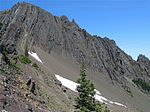Eagle Point (Olympic Mountains)
Landforms of Olympic National ParkMountains of Clallam County, WashingtonMountains of Washington (state)Olympic Mountains

Eagle Point is a 6,247 feet (1,904 m) summit in the Olympic Mountains and is located in Clallam County of Washington state. It is set on Hurricane Ridge within Olympic National Park. It's situated midway between Steeple Rock and Obstruction Peak, 1.42 mi (2.29 km) to the southeast. Precipitation runoff drains into tributaries of the Elwha River and Morse Creek, thence into the Strait of Juan de Fuca.
Excerpt from the Wikipedia article Eagle Point (Olympic Mountains) (License: CC BY-SA 3.0, Authors, Images).Eagle Point (Olympic Mountains)
Eagle Point Trail,
Geographical coordinates (GPS) Address External links Nearby Places Show on map
Geographical coordinates (GPS)
| Latitude | Longitude |
|---|---|
| N 47.939252 ° | E -123.409067 ° |
Address
Eagle Point Trail
Eagle Point Trail
Washington, United States
Open on Google Maps







